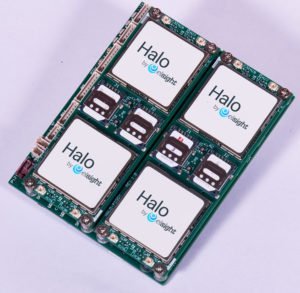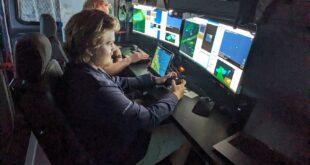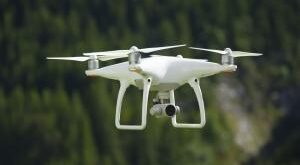For safe operation beyond visual line of sight (BVLOS), drones need rock solid connectivity. We spoke with Yoav Amitai, CEO of Israel’s Elsight – a technology company ready to provide connectivity for drones, a critical piece of the safety case for BVLOS and distant remote operations.
Yoav has served in a variety of executive roles in Elsight, taking a major part in initiating and executing the company’s strategic transition from a project-based to a product-oriented company: leveraging Elsight’s advanced technology and shaping its technological and business vision. Before Elsight, Yoav served as the GM of an engineering firm, bringing extensive operations, technology, and engineering management experience to the table.
We spoke to Yoav Amitai about communications and connectivity for drones.
 Elsight was founded in 2009, focusing on the business of video and audio transmission technologies. “The company was mostly working with homeland security type organizations like the Israeli Police, military, fire department, prison authorities, special units and more,” says Amitai.
Elsight was founded in 2009, focusing on the business of video and audio transmission technologies. “The company was mostly working with homeland security type organizations like the Israeli Police, military, fire department, prison authorities, special units and more,” says Amitai.
“As our experience in this field grew we began realizing the potential of connectivity as a whole – and with a strong R&D team, led by Roee Kashi our CTO and co-founder, we developed our signature bonding technology. Our technology essentially utilizes any existing network infrastructure to enhance connectivity capabilities even in the most challenging environments,” Amitai explains. “We packed our unique bonding technology into our first in house product, the Multichannel device, which provided connectivity services, including video, audio and any kind of data transmission from the field to headquarters and vice versa.”
Based on that technology, Elsight went public in 2017 (IPO @ ASX: ELS) and rapidly expanded their business. Working mostly on homeland security use cases, Elsight found a ready market. “Moving or stationary, manned or unmanned, we provided connectivity wherever it was needed,” says Amitai.
Connectivity for Drones: Reliability on an Always Moving Platform
That deep experience led to the development of Elsight’s flagship product, the Halo connectivity platform: Halo is an ideal solution for providing connectivity for drones. “Halo is packed with our unique bonding technology while featuring a small form factor, extremely low power consumption, minimal weight and hybrid networking capabilities – which make it an ideal connectivity solution for unmanned platforms (UAV’s, UAS’s, drones, UGV’s robots etc.),” says Amitai. “Our mission is to provide reliability to an always moving platform, and Halo is the key.”

Halo
“Halo is based on Elsight’s unique, connectivity technology that ensures near-real-time high-bandwidth transmission from anywhere, to anywhere,” explains Amitai. “Taking advantage of multiple data links and existing network infrastructure, it maximizes the efficiency of available resources. Halo adapts to your requirements and provides low-latency transmission of any data.”
Elsight’s powerful bi-directional algorithm splits any kind of data (video, audio, telemetry and more) into encrypted packets, using secure VPN tunnelling to transmit via multiple cellular and RF IP links, and decrypting and recombining at the destination. The algorithm automatically detects any failed channels, and seamlessly switches to the most suitable available transmission method.
“The idea is to integrate the OEM version of Halo into unmanned platforms,” Amitai says. “It becomes an integral part of the unmanned platform.”
Manufacturers who want to operate beyond visual line of sight (BVLOS) are Elsight’s primary clients, integrating Halo as an OEM solution. Automated drone pioneers Airobotics, for example, are among Elsight’s clients. (Manufacturers interested can book a demo at Elsight.com.) For urban or rural operations, military or commercial applications, BVLOS flight requires reliable connectivity.
“Halo is used now, and we envision it being massively used in the future, for BVLOS operations of UAVs,” says Amitai. “Either over populated areas, or less populated areas, Halo enables operations in almost any terrain.”
“We understand that the future of commercially deploying UAVs, under an ongoing approval of the regulator, requires reliability that is almost unbreakable – that is what we are aiming for. We want to assist manufacturers with scaling their operations with regulatory approvals. That is an enabler for any unmanned application.”
Miriam McNabb is the Editor-in-Chief of DRONELIFE and CEO of JobForDrones, a professional drone services marketplace, and a fascinated observer of the emerging drone industry and the regulatory environment for drones. Miriam has penned over 3,000 articles focused on the commercial drone space and is an international speaker and recognized figure in the industry. Miriam has a degree from the University of Chicago and over 20 years of experience in high tech sales and marketing for new technologies.
For drone industry consulting or writing, Email Miriam.
TWITTER:@spaldingbarker
Subscribe to DroneLife here.
https://dronelife.com/2020/10/26/bvlos-flight-requires-rock-solid-connectivity-for-drones-meet-elsights-halo/
 Unmanned Aerial Vehicle The latest drone news
Unmanned Aerial Vehicle The latest drone news




